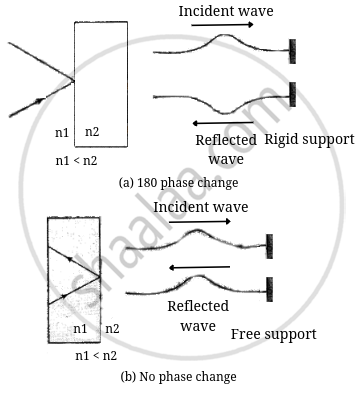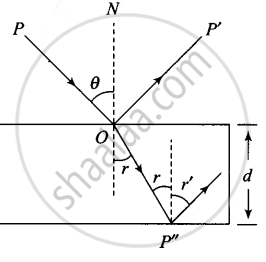Advertisements
Advertisements
प्रश्न
Consider a ray of light incident from air onto a slab of glass (refractive index n) of width d, at an angle θ. The phase difference between the ray reflected by the top surface of the glass and the bottom surface is ______.
पर्याय
`(4πd)/λ (1 - 1/n^2 sin^2 θ)^(1/2) + π`
`(4πd)/λ (1 - 1/n^2 sin^2 θ)^(1/2)`
`(4πd)/λ (1 - 1/n^2 sin^2 θ)^(1/2) + π/2`
`(4πd)/λ (1 - 1/n^2 sin^2 θ)^(1/2) + 2π`
उत्तर
Consider a ray of light incident from air onto a slab of glass (refractive index n) of width d, at an angle θ. The phase difference between the ray reflected by the top surface of the glass and the bottom surface is `underline((4πd)/λ (1 - 1/n^2 sin^2 θ)^(1/2) + π)`.
Explanation:
If slab of a glass is placed in air, the wave reflected from the upper surface (from a denser medium) sutlers a sudden phase change of π, while the wave reflected from the lower surface (from a rarer medium) suffers no such phase change.
It is useful to draw an analogy between reflected light waves and the reflections of a transverse wave on a stretched string when the wave meets a boundary:
Figure (a) shows that ray reflecting from a medium of higher refractive index undergoes a 180° phase change.

Now consider the diagram, the ray (P) is incident at an angle θ and gets reflected in the direction P' and refracted in the direction P". Due to reflection from the glass medium, there is a phase change of π.

Time taken to travel along OP"
Δt = `(OP^")/v = (d/(cos r))/(c/n) = (nd)/(c cos r)`
From Snell's law, n = `sin θ/sin r`
⇒ `sin r = sin θ/n`
`cos r = sqrt(1 - sin^2r) = sqrt(1 - (sin^2θ)/v^2)`
Phase difference, `Δphi = (2pi)/T xx Δt` ⇒ `Δphi = (2pind)/λ (1 - (sin^2θ)/n^2)^(-1/2)`
So, net phase difference = `Δphi + pi`
⇒ `Δphi_("net") = (4pid)/λ (1 - 1/n^2 sin^2θ) + pi`
APPEARS IN
संबंधित प्रश्न
Light waves each of amplitude "a" and frequency "ω", emanating from two coherent light sources superpose at a point. If the displacements due to these waves are given by y1 = a cos ωt and y2 = a cos(ωt + ϕ) where ϕ is the phase difference between the two, obtain the expression for the resultant intensity at the point.
As you have learnt in the text, the principle of linear superposition of wave displacement is basic to understanding intensity distributions in diffraction and interference patterns. What is the justification of this principle?
A tuning fork of frequency 480 Hz is used to vibrate a sonometer wire having natural frequency 240 Hz. The wire will vibrate with a frequency of
A tuning fork of frequency 480 Hz is used to vibrate a sonometer wire having natural frequency 410 Hz. The wire will vibrate with a frequency
A sonometer wire having a length of 1⋅50 m between the bridges vibrates in its second harmonic in resonance with a tuning fork of frequency 256 Hz. What is the speed of the transverse wave on the wire?
Answer briefly.
State and explain the principle of superposition of waves.
The energy in the superposition of waves ____________.
If `sqrt("A"^2+"B"^2)` represents the magnitude of resultant of two vectors `(vec"A" + vec"B")` and `(vec"A" - vec"B")`, then the angle between two vectors is ______.
For the harmonic travelling wave y = 2 cos 2π (10t – 0.0080x + 3.5) where x and y are in cm and t is second. What is the phase difference between the oscillatory motion at two points separated by a distance of 4 m.
For the harmonic travelling wave y = 2 cos 2π (10t – 0.0080x + 3.5) where x and y are in cm and t is second. What is the phase difference between the oscillatory motion at two points separated by a distance of What is the phase difference between the oscillation of a particle located at x = 100 cm, at t = T s and t = 5 s?
